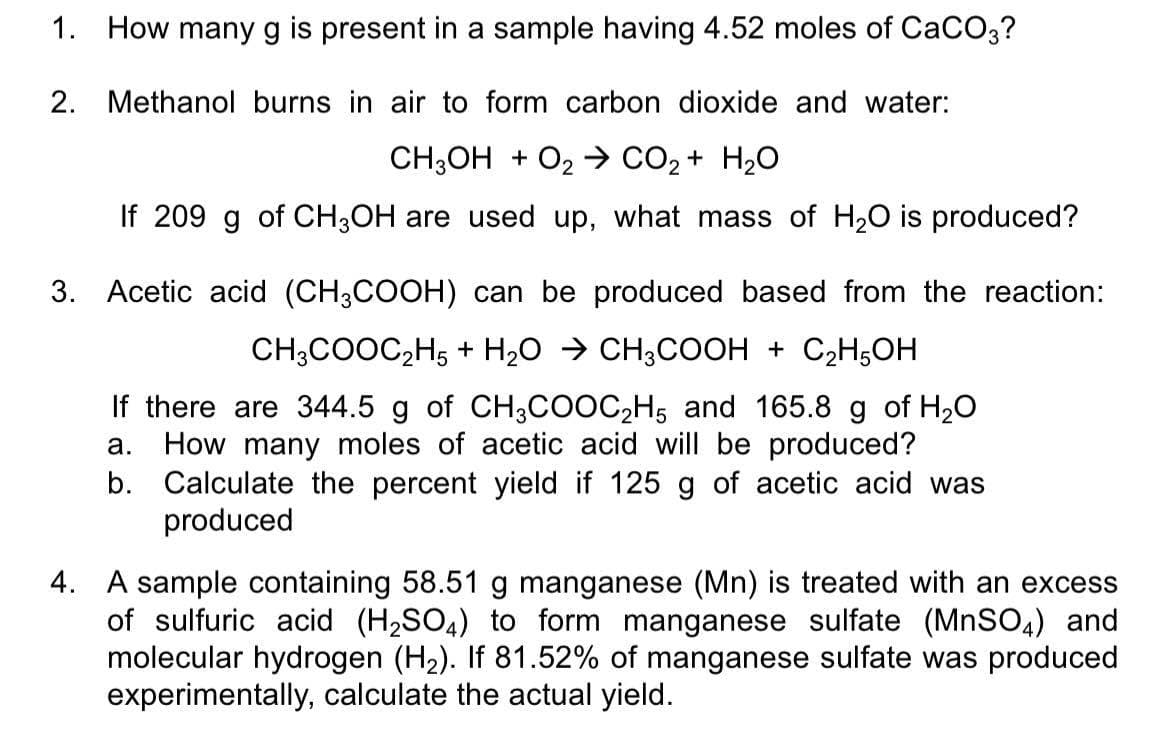1. How many g is present in a sample having 4.52 moles of CaCO3? 2. Methanol burns in air to form carbon dioxide and water: CH;OH + O2 > CO2 + H20 If 209 g of CH;OH are used up, what mass of H20 is produced? 3. Acetic acid (CH3COOH) can be produced based from the reaction: CH;COOC,H5 + H20 > CH;COOH + C2H5OH If there are 344.5 g of CH3COOC,H5 and 165.8 g of H20 a. How many moles of acetic acid will be produced? b. Calculate the percent yield if 125 g of acetic acid was produced 4. A sample containing 58.51 g manganese (Mn) is treated with an excess of sulfuric acid (H2SO4) to form manganese sulfate (MnSO,) and molecular hydrogen (H2). If 81.52% of manganese sulfate was produced experimentally, calculate the actual yield.
1. How many g is present in a sample having 4.52 moles of CaCO3? 2. Methanol burns in air to form carbon dioxide and water: CH;OH + O2 > CO2 + H20 If 209 g of CH;OH are used up, what mass of H20 is produced? 3. Acetic acid (CH3COOH) can be produced based from the reaction: CH;COOC,H5 + H20 > CH;COOH + C2H5OH If there are 344.5 g of CH3COOC,H5 and 165.8 g of H20 a. How many moles of acetic acid will be produced? b. Calculate the percent yield if 125 g of acetic acid was produced 4. A sample containing 58.51 g manganese (Mn) is treated with an excess of sulfuric acid (H2SO4) to form manganese sulfate (MnSO,) and molecular hydrogen (H2). If 81.52% of manganese sulfate was produced experimentally, calculate the actual yield.
Chemistry: An Atoms First Approach
2nd Edition
ISBN:9781305079243
Author:Steven S. Zumdahl, Susan A. Zumdahl
Publisher:Steven S. Zumdahl, Susan A. Zumdahl
Chapter5: Stoichiometry
Section: Chapter Questions
Problem 138AE: Terephthalic acid is an important chemical used in the manufacture of polyesters and plasticizers....
Related questions
Question

Transcribed Image Text:1. How many g is present in a sample having 4.52 moles of CaCO3?
2. Methanol burns in air to form carbon dioxide and water:
CH;OH + O2 → CO2 + H20
If 209 g of CH;OH are used up, what mass of H20 is produced?
3. Acetic acid (CH3COOH) can be produced based from the reaction:
CH;COOC,H5 + H20 > CH;COOH + C2H5OH
If there are 344.5 g of CH3COOC,H5 and 165.8 g of H20
a. How many moles of acetic acid will be produced?
b. Calculate the percent yield if 125 g of acetic acid was
produced
4. A sample containing 58.51 g manganese (Mn) is treated with an excess
of sulfuric acid (H2SO4) to form manganese sulfate (MnSO,) and
molecular hydrogen (H2). If 81.52% of manganese sulfate was produced
experimentally, calculate the actual yield.
Expert Solution
This question has been solved!
Explore an expertly crafted, step-by-step solution for a thorough understanding of key concepts.
This is a popular solution!
Trending now
This is a popular solution!
Step by step
Solved in 2 steps with 2 images

Knowledge Booster
Learn more about
Need a deep-dive on the concept behind this application? Look no further. Learn more about this topic, chemistry and related others by exploring similar questions and additional content below.Recommended textbooks for you

Chemistry: An Atoms First Approach
Chemistry
ISBN:
9781305079243
Author:
Steven S. Zumdahl, Susan A. Zumdahl
Publisher:
Cengage Learning

Chemistry: Principles and Reactions
Chemistry
ISBN:
9781305079373
Author:
William L. Masterton, Cecile N. Hurley
Publisher:
Cengage Learning

Chemistry by OpenStax (2015-05-04)
Chemistry
ISBN:
9781938168390
Author:
Klaus Theopold, Richard H Langley, Paul Flowers, William R. Robinson, Mark Blaser
Publisher:
OpenStax

Chemistry: An Atoms First Approach
Chemistry
ISBN:
9781305079243
Author:
Steven S. Zumdahl, Susan A. Zumdahl
Publisher:
Cengage Learning

Chemistry: Principles and Reactions
Chemistry
ISBN:
9781305079373
Author:
William L. Masterton, Cecile N. Hurley
Publisher:
Cengage Learning

Chemistry by OpenStax (2015-05-04)
Chemistry
ISBN:
9781938168390
Author:
Klaus Theopold, Richard H Langley, Paul Flowers, William R. Robinson, Mark Blaser
Publisher:
OpenStax


Chemistry
Chemistry
ISBN:
9781305957404
Author:
Steven S. Zumdahl, Susan A. Zumdahl, Donald J. DeCoste
Publisher:
Cengage Learning

Chemistry & Chemical Reactivity
Chemistry
ISBN:
9781337399074
Author:
John C. Kotz, Paul M. Treichel, John Townsend, David Treichel
Publisher:
Cengage Learning